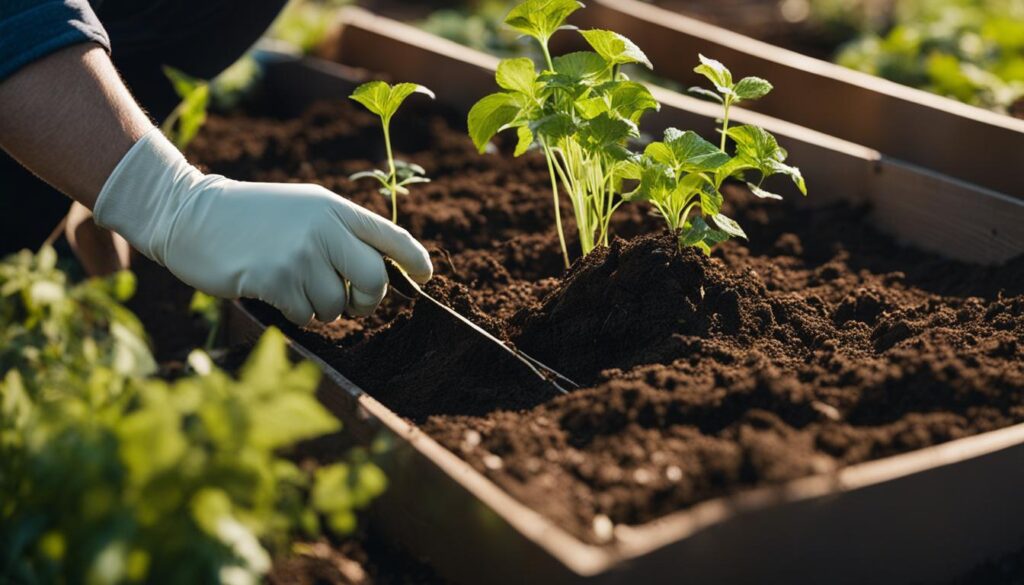If you’re looking to remove a raised garden bed from your yard, we’ve got you covered. Whether you want to make space for a traditional garden bed or blend it into your existing landscape, this step-by-step guide will walk you through the process. Let’s get started!
Post Summary:- Removing a raised garden bed involves pulling out weeds, removing the side boards, and amending the soil.
- Tools and materials needed for the task include a shovel, spade, hoe or pitchfork, pry bar, compost or fertilizer, and more.
- Clearing out an old garden requires different approaches based on the type of garden.
- After clearing out the garden, remove weeds and prepare the soil for new plants.
- Finally, plant new grass or create a new flower bed to complete the process.
Tools and Materials Needed for Removing a Raised Bed
To successfully remove a raised bed from your garden, you’ll need specific tools and materials to make the process easier and more efficient. Here’s a list of what you’ll need:
- Shovel: A sturdy shovel will help you dig out the soil around the raised bed.
- Spade: A spade can be used to loosen the soil and cut through any stubborn roots.
- Hoe or Pitchfork: These tools are useful for breaking up the soil and removing any remaining debris.
- Pry Bar: A pry bar can be handy for carefully lifting and removing the side boards of the raised bed.
- Wheelbarrow or Tarp: You’ll need a means to transport the removed soil and debris from the raised bed.
- Compost and/or Fertilizer: After removing the raised bed, you may want to amend the soil with compost or fertilizer to improve its quality.
- Hammer and/or Screwdriver: These tools can be helpful for disassembling the raised bed if it’s held together with fasteners.
- Weed Killer (optional): If the raised bed is overrun with weeds, you may want to use a weed killer to eliminate them.
- Soil pH Testing Kit (optional): Testing the soil pH can help you determine if any adjustments need to be made before planting new vegetation.
Having these tools and materials readily available will ensure you’re well-equipped to tackle the task of removing a raised bed from your garden. Remember to use them responsibly and take proper care to avoid any injuries.
Now that you know what tools and materials you’ll need, let’s move on to the step-by-step process of removing a raised bed. But before that, take a look at the table below for a quick summary of the tools and materials needed:
| Tools | Materials |
|---|---|
| Shovel | Compost and/or Fertilizer |
| Spade | Hammer and/or Screwdriver |
| Hoe or Pitchfork | Weed Killer (optional) |
| Pry Bar | Soil pH Testing Kit (optional) |
| Wheelbarrow or Tarp |

With these tools and materials in hand, you’re ready to take on the task of removing a raised bed from your garden. The next section will guide you through the step-by-step process to ensure a successful removal.
Steps to Clearing Out an Old Garden
Clearing out an old garden can be a daunting task, but with the right approach, it can be done efficiently. Before you begin, assess the type of garden you have, whether it’s a vegetable garden, flower bed, or includes small trees and shrubs. Each type requires a different approach for clearing out.
Clearing Out a Vegetable Garden
If you have a vegetable garden, start by harvesting as much as possible. Gather the ripe produce and consider starting a compost pile with any leftover plant material. Composting will help you recycle nutrients and create rich soil for future garden beds. Remember to remove any diseased plants or weeds from the garden to prevent the spread of pests and diseases.
Clearing Out a Flower Bed
For a flower bed, salvage any plants you want to keep and transplant them to a new location if necessary. Carefully remove any unwanted plants and dispose of them or add them to your compost pile. It’s important to remove the entire root system of unwanted plants to prevent regrowth. After clearing the bed, consider adding fresh soil or compost to prepare it for new plants.
Clearing Out Small Trees and Shrubs
If you have small trees or shrubs in your garden that need to be removed, it’s important to plan ahead. Start by pruning away any branches or foliage to make the removal process easier. Dig around the base of the tree or shrub, gradually loosening the soil and exposing the root system. Use a shovel or spade to carefully lift the plant out of the ground, ensuring you remove all the roots. Dispose of the plant or consider transplanting it to a new location.
By following these steps, you can efficiently clear out your old garden and prepare it for new plants or landscaping. Remember to dispose of any unwanted plants responsibly and consider recycling plant material through composting. With a fresh start, you’ll be ready to create a beautiful new garden space.
Removing Weeds and Preparing the Soil
After clearing out the old garden, the next step is to remove weeds and prepare the soil. Weeds can hinder the growth of new plants, stealing nutrients and sunlight. To ensure your new garden thrives, it’s essential to eliminate these unwanted pests.
One effective method is using weed killers specifically designed for gardens. Glyphosate-based weed killers like Roundup are popular options to consider. These products work by targeting the weeds’ roots, preventing them from regrowing. However, if you prefer a more natural approach, there are alternative options available. Solarization, for instance, is a chemical-free process that involves covering the area with plastic to heat the soil and kill weeds and pests.
Once the weeds are eradicated, it’s time to prepare the soil for new plants. Start by loosening the soil with a spade or a garden fork. This will allow for better air circulation and root development. Next, add compost or fertilizer to enrich the soil with essential nutrients. Consider conducting a soil pH test to determine if any amendments are necessary. Adjusting the pH level can significantly improve the overall health and growth of your plants.
Common Weed Killers and their Features
| Weed Killer | Main Ingredient | Effectiveness | Application | Precautions |
|---|---|---|---|---|
| Roundup | Glyphosate | High | Spray directly on weeds | Wear protective clothing and avoid contact with desirable plants |
| Vinegar | Acetic acid | Moderate | Spray directly on weeds | Avoid contact with desirable plants |
| Corn Gluten Meal | Organic compound | Low | Apply as a pre-emergent | Timing is crucial for effectiveness |
By effectively removing weeds and preparing the soil, you’re creating an optimal environment for your new plants to flourish. Taking these steps will set the stage for a healthy and thriving garden.

Can I Remove a Raised Garden Bed Without Damaging the Concrete?
Yes, you can remove raised garden beds on concrete without causing damage. Start by clearing the area and disconnecting any attached components. Use a pry bar or shovel to gently lift and loosen the garden bed from the concrete. Take caution not to scrape or chip the surface. With careful maneuvering, you can relocate or replace the garden bed without leaving any lasting marks.
Planting New Grass or Flower Bed
Now that you’ve successfully removed the raised garden bed and cleared out the old plants, it’s time to breathe new life into your garden. Whether you’re looking to plant a lush, green lawn or create a vibrant flower bed, this section will guide you through the process.
If you’re planning to plant new grass, start by preparing the soil. Ensure that it is free from any debris or weeds. Spread the grass seeds evenly across the soil and mix them in gently. Water the area regularly to keep the soil moist until the seeds germinate. Once the grass starts to grow, continue watering as needed and mow it regularly to maintain a healthy and beautiful lawn.
If a colorful flower bed is more your style, select the plants you want to grow based on your climate and personal preferences. Dig small holes in the prepared soil and carefully place each plant in its designated spot. Ensure that you provide enough space for the plants to grow and thrive. Water your flower bed regularly, especially during dry spells, and apply fertilizers according to the specific needs of your chosen plants.
Remember to consider the maintenance requirements of your new lawn or flower bed. Regular watering, fertilizing, and mowing will be essential to keep them looking their best. Additionally, be vigilant about weeding to prevent unwanted plants from taking over your carefully cultivated space. With proper care and attention, your new grass or flower bed will flourish and enhance the beauty of your outdoor area.
FAQ
How do I get rid of a raised garden bed?
To remove a raised bed from a garden, follow these steps: pull out all the weeds, use a shovel to remove the dirt, remove and dispose of the raised bed’s side boards, stir up the remaining dirt, amend it with compost or fertilizer.
What tools and materials do I need for removing a raised bed?
You will need a shovel, spade, hoe or pitchfork, pry bar, wheelbarrow or tarp, compost and/or fertilizer, hammer and/or screwdriver, weed killer (optional), and a soil pH testing kit (optional).
How do I clear out an old garden?
Clearing out an old garden involves different approaches depending on the type. For a vegetable garden, harvest as much as possible and consider starting a compost. For a flower bed, salvage plants you want to keep and dispose of or compost the ones you don’t want. Removing a small tree or shrub requires careful planning and digging up the root system.
How do I remove weeds and prepare the soil?
After clearing out the old garden, use weed killers or natural methods to eliminate existing weeds and prevent weed seeds from germinating. Once the weeds are removed, prepare the soil by adding compost, fertilizer, and any necessary amendments based on a soil test.
How do I plant new grass or create a new flower bed?
Sow grass seeds on properly prepared soil, making sure to evenly spread the seeds and mix them with the soil. Water the area regularly until the seeds germinate. For a flower bed, follow the planting procedure for the specific plants you want to grow. Maintain the new lawn or flower bed by watering, fertilizing, and mowing as needed.








